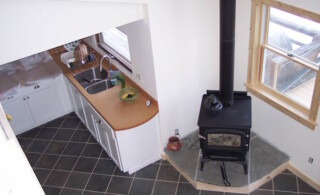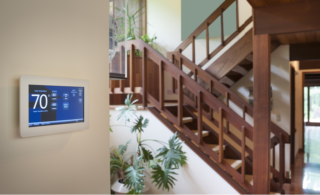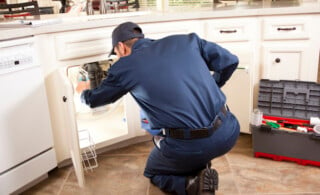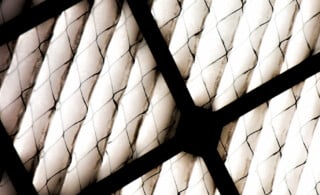 Photo: Anastasiia Shavshyna / E+ / Getty Images
Photo: Anastasiia Shavshyna / E+ / Getty Images
An ideal time to start winterizing your home is before the snow season hits. Heating the house during the winter, however, consumes a lot of energy. It’s also when homeowners typically experience a spike in their utility bills.
A home energy audit from a local professional can help you strategize ways to save energy and cut down on utility bills. Alternatively, if you’re on a budget, there are other effective methods to reduce your heating bill without breaking the bank. Here are 25 frugal ways to keep your home warm and toasty all winter long.
1. Add Rugs to Hard Floors
 Photo: kate_sept2004 / E+ / Getty Images
Photo: kate_sept2004 / E+ / Getty Images
Did you know you can lose about 10% of the heat in your home through uninsulated floors, such as tile and hardwood? Throw a few area rugs in those rooms with hard-surface floors, especially in finished basement rooms, to help reduce heat loss and keep your feet warm.
2. Install Attic Insulation
Just as with floors, the attic is also where your home can lose heat when it’s not properly insulated. You can install the insulation batts yourself or hire a local attic insulation company to ensure a proper seal.
3. Light Up the Fireplace
 Photo: ksvetikd / E+ / Getty Images
Photo: ksvetikd / E+ / Getty Images
Relaxing fireside is a popular way to keep yourself warm without using any utilities. A lit fireplace can also create a cozy, inviting atmosphere, especially when having guests over for the holidays.
4. Use Fireplace Plugs
Also known as chimney pillows and flue blockers, fireplace plugs are a budget-friendly way to cut off drafts from the chimney. Install these in the fireplace whenever it’s not in use to insulate the indoor heat.
5. Use Shower Steam
Warming up in a hot shower? Take advantage of the shower steam and allow it to permeate. Alternatively, if you take a hot bath, hold off on draining the tub. The heat from the water can help keep the bathroom warm.
6. Rearrange the Furniture
 Photo: andresr / E+ / Getty Images
Photo: andresr / E+ / Getty Images
Take a look at your current furniture arrangement. Is anything covering or blocking the vents or radiator? If so, they can prevent heat flow into the home. Consider moving some of the furniture to other areas of the room to permit air circulation.
7. Lower the Thermostat
If you’re away from home most of the time, such as for work, there’s no need to keep the heat running all day. Turning down the thermostat a few degrees saves both energy and money on your heating bill. A smart thermostat is an ideal investment for this scenario because you can preset temperatures at different times throughout the day.
8. Perform HVAC Maintenance
 Photo: fstop123 / E+ / Getty Images
Photo: fstop123 / E+ / Getty Images
Routinely check your HVAC system to make sure it’s running properly. Doing so can save you money in the long run, especially if your HVAC needs to be replaced. While the cost of HVAC repairs are around $300, replacing an entire HVAC system can average around $7,000.
To avoid running into appliance repair issues during the cold months, it’s best to make a winter prep checklist of all necessities to do to the house beforehand:
 Photo: InspirationGP / iStock / Getty Images
Photo: InspirationGP / iStock / Getty Images
9. Hang Heavy Window Drapes
 Photo: svetikd / E+ / Getty Images
Photo: svetikd / E+ / Getty Images
Thick drapes or curtains can serve as an additional layer of insulation for windows. Use them to your advantage during the colder months to keep the window chill out and the warm air inside.
10. Adjust the Water Heater
 Photo: Minerva Studio / iStock / Getty Images
Photo: Minerva Studio / iStock / Getty Images
Hot water heaters use a lot of energy. Since you’ll most likely use more hot water during the winter, consider lowering the water heater temperature a few degrees. You may not feel much of a difference, but you’ll notice a change for the better in the gas or electric bill.
11. Reverse the Ceiling Fan Rotation
If your ceiling fan model has a reverse switch, use it. Since warm air rises, turning the blade clockwise during winter will help push the air downward and back into your living space.
12. Close Doors of Unused Rooms
If you spend little to no time in a particular room, there’s no need to keep it heated. Close those doors to keep the rest of the house warm.
13. Cover the Pet Doors
Don’t forget about the cat and doggy doors. Although small, pet door installations can still contribute to heat loss. To reduce drafts, consider sealing off the door during the winter. It may be an inconvenience, but can save a lot on your electricity bill.
14. Leave the Faucets Dripping
 Photo: nikkytok / iStock / Getty Images
Photo: nikkytok / iStock / Getty Images
To help prevent your pipes from freezing and bursting during winter, it’s recommended to leave the faucets dripping during the day. This will promote water flow and melt away any frozen areas forming.
15. Let in Sunshine
Use solar heat to your advantage during winter. By keeping your curtains open during the day, the sunlight can work as a natural heater for your home.
16. Keep Blankets Handy
 Photo: LumiNola / E+ / Getty Images
Photo: LumiNola / E+ / Getty Images
Not only do blankets keep you warm and toasty, but they can also double as an alternative insulator. Pin a blanket over a door or on the floor if you don’t have any rugs.
17. Install a Door Sweep
Drafts can seep in through the cracks and bottom edge of a door, especially if it’s an old one. To prevent this, install a door sweep between the door bottom and the threshold. Alternatively, you can place a rolled-up towel or blanket in this area as a temporary sealant.
18. Use Window Film
Window insulation film acts as an additional barrier between your home and the window, keeping the warm air inside and the cold air out. If you’re on a budget, using shrink wrap on windows also gets the job done.
19. Boil a Pot of Water
 Photo: ablokhin / iStock / Getty Images
Photo: ablokhin / iStock / Getty Images
Since humidity carries heat, you can boil up some water to add warmth to the kitchen. Use it to make yourself a cup of hot tea or to refill hot water bottles as homemade blanket warmers.
20. Install a Storm Door
Thinking of upgrading your entryway? Consider a storm door. This easy home improvement is a year-round energy-efficient hack to defend against the winter cold and summer heat.
21. Wrap Your Pipes
Frozen water pipes during the winter are a serious problem. They can burst from pressure and flood the home, resulting in thousands of dollars of water damage. To prevent this, wrap your pipes with pipe sleeves or heating cables to help insulate them. Using a newspaper or an old towel also works as a budget-friendly alternative.
22. Change the Furnace Filter
 Photo: BanksPhotos / iStock / Getty Images
Photo: BanksPhotos / iStock / Getty Images
It’s recommended to change or clean the filters on your furnaces at least once a month during the winter months. This will help save on home energy costs and improve the longevity of your furnace system.
23. Keep the Vents Open
While closing vents may sound rational, it can ultimately do more harm than good. Pushing air to closed vents can force your HVAC system to work harder, as they’re built to heat the entire home. It’s best to keep your vents open to save energy.
24. Add Garage Door Insulation
Similar to door cracks, cold air can seep through your garage door. Add layers of foam board to your garage door to help block any drafts.
25. Seal Up Cracks and Gaps
Once you seal your doors and windows, don’t stop there. From floor cracks to holes in your home’s exterior, there are many hidden areas where drafts can sneak into your home. Track down these areas and fill them with sealants, such as caulk.
These 25 hacks are effective and affordable ways to winterize your home and save you from surprising utility bills during the snow season. Should you need any professional help, hire a top-rated local pro to ensure your home is energy-efficient.
 Photos: FreshSplash / E+ / Getty Images; irin-k / Shutterstock; SolStock / E+ / Getty Images; Andrew Angelov / Shutterstock; romrodinka / iStock / Getty Images; tab1962 / iStock / Getty Images; Pyrosky / E+ / Getty Images; krblokhin / iStock / Getty Images; Monkey Business Images / Shutterstock; KenWiedemann / iStock / Getty Images; New Africa / Shutterstock
Photos: FreshSplash / E+ / Getty Images; irin-k / Shutterstock; SolStock / E+ / Getty Images; Andrew Angelov / Shutterstock; romrodinka / iStock / Getty Images; tab1962 / iStock / Getty Images; Pyrosky / E+ / Getty Images; krblokhin / iStock / Getty Images; Monkey Business Images / Shutterstock; KenWiedemann / iStock / Getty Images; New Africa / Shutterstock

 Understanding Wood Stoves
Understanding Wood Stoves  How to Choose the Best Smart Thermostat for Your Home
How to Choose the Best Smart Thermostat for Your Home  Why Business is Booming for Mechanical Contractors, and What That Means for Home Improvement
Why Business is Booming for Mechanical Contractors, and What That Means for Home Improvement  Electric vs. Gas Fireplace: Which Is Better for Your Home?
Electric vs. Gas Fireplace: Which Is Better for Your Home?  Types of Furnace Filters & How to Clean Them
Types of Furnace Filters & How to Clean Them 

Are You Familiar With This Topic? Share Your Experience.